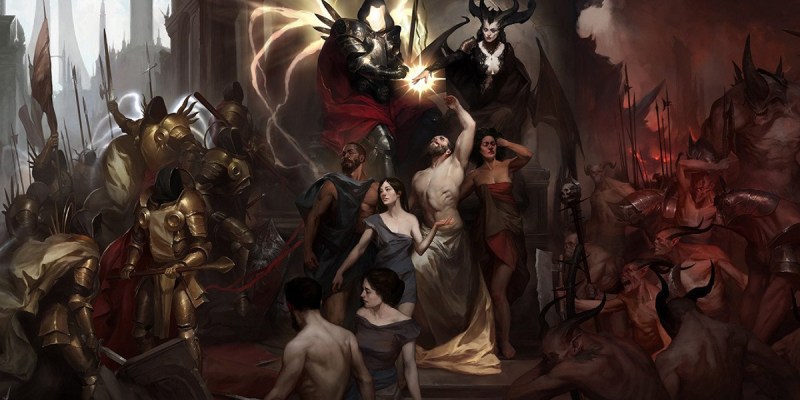More than one month into Diablo IV, we’re already looking ahead at season 1, but many launch-day warriors are still battling their way through the surprisingly large campaign. I myself slayed Lilith for the first time roughly three weeks ago and have since been waiting in silence for the new season, trying not to burn myself out with the endgame in the Eternal Realm before the seasonal reset arrives. This has given me some space to think about what, in my humble opinion, works and what doesn’t in the game’s main storyline.
From the get-go, Diablo IV was marketed as a much darker installment than III, which overall felt more like a regular fantasy setting besieged by demons and other monsters. I’ve expressed in the past I was perfectly okay with the series going off and trying out something else, both visually and gameplay-wise. It still largely felt like Diablo where it mattered, and I dug the more flexible progression system and almost everything that came with the Reaper of Souls expansion. Another side effect of such changes was a bigger main story that felt like a major event in the war between Hell and Heaven. Even beyond the sick CG cutscenes, later environments evoked a level of epicness that had only been teased in the lore before.

Image via Blizzard Entertainment
Fast-forward to Diablo IV and we find Sanctuary on the brink of collapse, still reeling from Malthael’s savage attack on humanity and the damage done over the years by the Eternal Conflict and the continuous clashes of heroes and villains. Diablo IV isn’t just grim and gothic. It’s also a post-apocalyptic tale about a world that might be facing a new apocalypse. Sanctuary’s younger generations have known nothing but misery and war, and Lilith’s twisted plan won’t make things better. Still, her nefarious actions don’t have too large (relatively speaking) of a discernible impact on the world, as Diablo IV goes surprisingly restrained with her world-ending threat.
I’ve always liked the idea of wars fought in the shadows. Of course, Diablo’s largely traditional action RPG gameplay – plus this installment’s MMO-like structure – doesn’t allow for such a story, yet most of our odyssey feels like glorified detective work. The key characters are always lagging behind Mephisto’s daughter, uncovering unspeakable crimes and plans that must be thwarted. The entire presentation of most major narrative events is spectacular and sets a new standard for the genre, yet it constantly feels we’re missing out on all the cool action. Again, I’m strictly speaking about the main campaign and not about the actual insanity happening as we cut down hordes of enemies and level up.

Image via Blizzard Entertainment
The game’s horror aspirations mostly worked for me. The artists and developers behind Diablo IV make a compelling case about the franchise belonging to the horror genre in its own way. But of course, enemies are as afraid of us as we are of them. Reach the endgame and you essentially become the Doom Slayer and turn the entire thing into reverse horror. It rocks. In fact, this game’s accentuated horror elements, especially early on, make the journey from just some vagrant fighter to Sanctuary’s new hero much more spiritually rewarding.
Diablo III immediately puts players inside a “chosen one” narrative and makes the mighty Nephalem its main focus. On the other hand, Diablo IV implies a bunch of stuff, and our characters are indeed special — but not in the way you’d expect. The connection to Lilith is presented as a curse that becomes the perfect tool for our ongoing detective work, and the main character is more of a reluctant hero with their heart in the right place. Amidst angels and demons, a soul that willfully chooses to resist temptation might be the savior that Sanctuary needs.
As we’re always finding out late about Lilith’s crimes, the “post-disaster” atmosphere is kept around all the way through. Diablo IV reveals itself to be vast long before we hit the endgame, and your definition of “epic” might vary. However, even when Hell is opened (shocking, I know) and we must venture into the maws of the darkness, all the action worthy of ancient murals is over before the gang arrives.

Image via Blizzard Entertainment
I wouldn’t say the decision to make Diablo IV a constant uphill race is wrong. As I said before, this approach works well in tandem with the horror aesthetics and pessimistic vibes that cover the entire map. It does, however, make me wonder if there was a conscious rejection of almost everything Diablo III did just to appease the old guard. I’d argue there’s more than enough room to accommodate both a gloomier, more intimate story and the grandeur you’d expect from the return of the freakin’ Creator of Sanctuary.
I loved learning everything about Lorath (all praise Ralph Ineson) and Elias’ shared past; Donan’s entire arc is heartbreaking but inspiring; Neyrelle is a new type of hero the series desperately needed… And yet, as the credits rolled, I was left feeling like we had just banded together to chase a demonic wild goose without actually pushing back against the overwhelming armies of evil (something that is teased time and again). Not even the online randos roaming around made the main course feel like a massive crusade. I love what’s in there, but it kinda sucks knowing we could have had it all.
